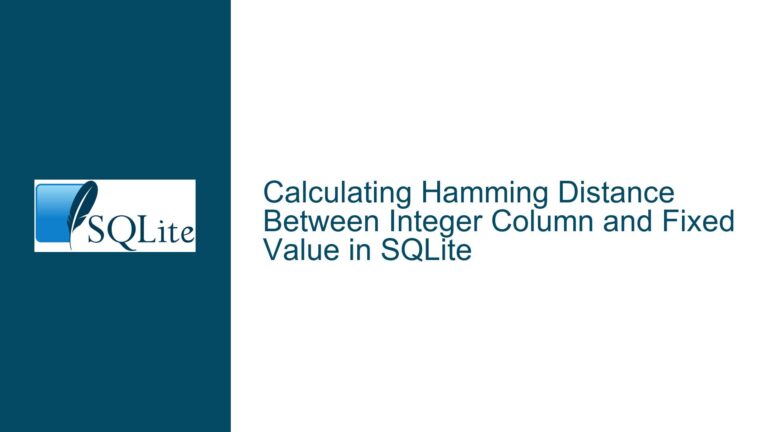SQLite Query Discrepancy: JOIN Behavior in Complex Queries
Unexpected Query Results Due to JOIN Logic and Data Types
The core issue revolves around two SQLite queries that, while logically equivalent, produce different results. The first query returns no rows, while the second query returns the expected data. This discrepancy arises from a combination of JOIN logic, data type mismatches, and potential indexing issues. The tables involved are market_selection_state, market_selection, and market_selection_status, with the primary focus on the market_selection_sysid and market_selection_status_sysid columns. The problem persists even in a fresh database with a subset of production data, suggesting that the issue is not due to database corruption but rather a subtle interaction between the schema design and query execution.
The market_selection_state table acts as a bridge between market_selection and market_selection_status, linking records via market_selection_sysid and market_selection_status_sysid. The market_selection_status table contains a small number of rows, with the value column used to filter records (e.g., value = "REMOVED"). The market_selection table contains a large number of rows, and its sysid column is used to join with market_selection_state. The discrepancy occurs when filtering by market_selection_sysid = 10 and joining these tables in different ways.
Data Type Mismatches and Implicit Type Conversions
One of the primary causes of the discrepancy is the difference in data types between the sysid columns in the market_selection and market_selection_state tables. The market_selection.sysid column is defined as [UNSIGNED INTEGER], while the market_selection_state.market_selection_sysid column is also defined as [UNSIGNED INTEGER]. However, SQLite does not enforce strict data types, and implicit type conversions can occur during JOIN operations. This can lead to unexpected behavior, especially when comparing values across columns with different underlying storage classes.
Additionally, the market_selection_status.value column is defined as TEXT, and the query filters rows where value = "REMOVED". While this comparison is straightforward, the interaction between the TEXT filter and the JOIN logic can introduce subtle issues, particularly if there are leading or trailing spaces in the value column or if the collation sequence affects the comparison.
Another potential cause is the lack of explicit indexing on the market_selection_sysid and market_selection_status_sysid columns. Without indexes, SQLite may perform full table scans or use less efficient join algorithms, which can exacerbate the impact of data type mismatches and implicit conversions. The absence of indexes also makes it harder to predict the query execution plan, leading to inconsistent results.
Resolving JOIN Discrepancies with Explicit Type Casting and Indexing
To address the discrepancy between the two queries, the first step is to ensure that the data types of the joined columns are consistent. This can be achieved by explicitly casting the sysid columns to the same type in both queries. For example, the market_selection.sysid and market_selection_state.market_selection_sysid columns can be cast to INTEGER to ensure that the JOIN operation is performed on compatible types. This eliminates the risk of implicit type conversions affecting the results.
The second step is to create indexes on the market_selection_sysid and market_selection_status_sysid columns in the market_selection_state table. Indexes improve query performance by allowing SQLite to quickly locate the relevant rows, reducing the likelihood of inconsistencies caused by full table scans. The following DDL statements can be used to create the necessary indexes:
CREATE INDEX idx_market_selection_state_sysid ON market_selection_state (market_selection_sysid);
CREATE INDEX idx_market_selection_state_status_sysid ON market_selection_state (market_selection_status_sysid);
The third step is to rewrite the queries to ensure that the JOIN logic is consistent and that the filtering conditions are applied correctly. The first query can be modified to explicitly cast the sysid columns and to use the same filtering logic as the second query. The rewritten query would look like this:
SELECT *
FROM market_selection_state ss
JOIN market_selection s ON (CAST(s.sysid AS INTEGER) = CAST(ss.market_selection_sysid AS INTEGER))
JOIN market_selection_status ssr ON (CAST(ssr.sysid AS INTEGER) = CAST(ss.market_selection_status_sysid AS INTEGER) AND ssr.value = "REMOVED")
WHERE ss.market_selection_sysid = 10;
The second query, which uses a Common Table Expression (CTE), can also be modified to ensure consistency:
WITH removeStatus AS (
SELECT *
FROM market_selection_state ss
JOIN market_selection_status ssr ON (CAST(ssr.sysid AS INTEGER) = CAST(ss.market_selection_status_sysid AS INTEGER) AND ssr.value = "REMOVED")
WHERE ss.market_selection_sysid = 10
)
SELECT r.*, s.*
FROM removeStatus r
JOIN market_selection s ON (CAST(s.sysid AS INTEGER) = CAST(r.market_selection_sysid AS INTEGER));
By explicitly casting the sysid columns and ensuring that the filtering conditions are applied consistently, the two queries should now return the same results. Additionally, the indexes on the market_selection_state table will improve query performance and reduce the likelihood of inconsistencies caused by full table scans.
Finally, it is important to validate the results of the queries to ensure that the changes have resolved the discrepancy. This can be done by comparing the output of the two queries and verifying that they return the same rows. If the discrepancy persists, further investigation may be required to identify any additional factors contributing to the issue, such as data anomalies or collation sequence differences.
In conclusion, the discrepancy between the two queries is primarily caused by data type mismatches and the lack of explicit indexing. By explicitly casting the sysid columns, creating indexes, and ensuring consistent JOIN logic, the issue can be resolved, and the queries will return the expected results. This approach not only addresses the immediate problem but also improves the overall performance and reliability of the database queries.






